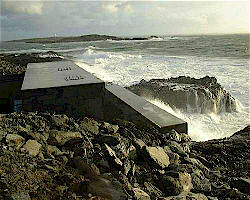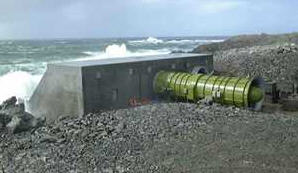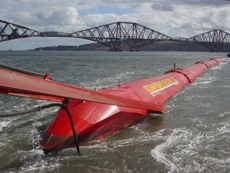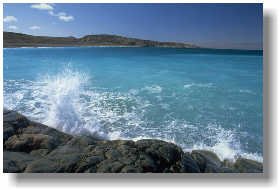![]()
![]()
![]()
![]()
![]()
![]()
![]()
![]()
![]()
![]()
![]()
This site is designed to be viewed on an
800 x 600 screen,
with level 4+ browsers.
Created by Andy Dervill
Science teacher at
Broadoak Community School England
Web site www.darvill.clara.net
Introduction How it works More details Advantages Disadvantages Is it renewable?
![]()
![]()
How it works
|
There are several methods of getting energy from waves, but one of the most effective works like a swimming pool wave machine in reverse. At a swimming pool, air is blown in and out of a chamber beside the pool, which makes the water outside bob up and down, causing waves. At a wave power station, the waves arriving cause the water in the chamber to rise and fall, which means that air is forced in and out of the hole in the top of the chamber. |
 |
We place a turbine in this hole, which is turned by the air rushing in and out. The turbine turns a generator.
A problem with this design is that the rushing air can be very noisy, unless a silencer is fitted to the turbine. The noise is not a huge problem anyway, as the waves make quite a bit of noise themselves.
![]()
More details
 
|
Once you've built it, the energy is free, needs no fuel and produces no waste or pollution. One big
problem is that of building and anchoring something that can
withstand the roughest conditions at sea, yet can generate a
reasonable amount of power from small waves. A company
called Wavegen now operate a commercial wave power station
called "Limpet" on the Scottish island of Islay,
|
|
| >>View
a simulation from the Greenpeace website, with a good animation of how "Limpet" works |
||
|
A company called Ocean Power Delivery are developing a method of offshore wave energy collection, using a floating tube called "Pelamis". This long, hinged tube (about the size of 5 railway carriages) bobs up and down in the waves, as the hinges bend they pump hydraulic fluid which drives generators. Find out more, including an interactive model, videos and technical details at www.oceanpd.com |
 |
![]()
Advantages
- The energy
is free - no fuel needed, no waste produced.
- Not expensive
to operate and maintain.
- Can produce a great deal of energy.
![]()
Disadvantages
- Depends on
the waves - sometimes you'll get loads of energy, sometimes nothing.
- Needs a suitable
site, where waves are consistently strong.
- Some designs
are noisy.
- Must be able to withstand very rough weather.
![]()
Is it renewable?
Wave power is renewable.
![]()
|
|
|
Want
to discuss alternative energy issues? by James Wilson |

